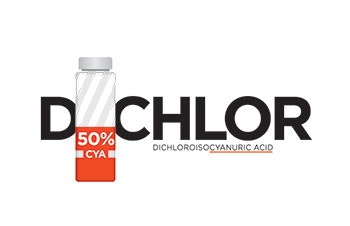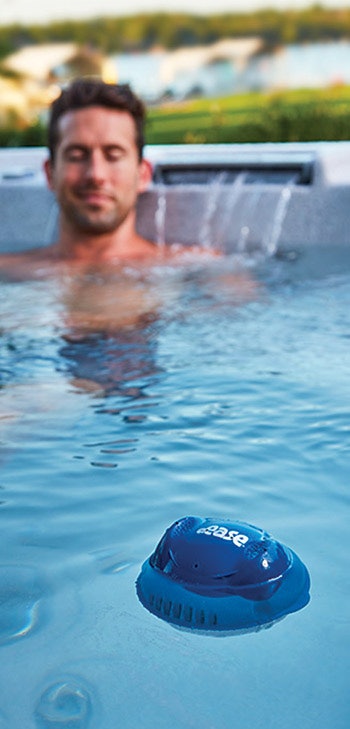
The following content is supported by one of our advertising partners. To learn more about sponsored content, click here.
Do your hot tub customers complain about smelly, itchy water that's hard to manage? Are they tired of having to drain and refill the water every couple of months? While you may think it's just poor water maintenance on the part of the hot tub owner, the problem could lie in a quickly rising cyanuric acid (CYA) level that affects chlorine's ability to sanitize.
What is CYA and Why Is It Used?
CYA (cyanuric acid, also known as conditioner or stabilizer) is a chemical first introduced into the swimming pool industry in 1956. Back then pools were commonly chlorinated with liquid chlorine like sodium hypochlorite or calcium hypochlorite that came in a powdered form. The problem is that chlorine is subject to degradation by the UV rays of the sun and therefore needs to be added once or even twice a day. The loss of chlorine in water to sunlight is 75% in 2 hours or a complete loss in 4 hours.
CYA keeps the chlorine in the water up to eight times longer. Pools that previously required daily chlorine additions now only need chlorine once a week with CYA. However, chlorine in the water quickly binds to CYA and a smaller portion of the chlorine is available. So the chlorine is around longer but it does not kill as quickly. And as the CYA increases, there is less and less chlorine available for killing bacteria and microorganisms.
Innovative chlorine manufacturers in the late 1950s started combining chlorine with CYA to make chlorinated isocyanurates called dichlor and trichlor. Trichlor tablets quickly became the most popular chlorinating product for pools.
CYA Buildup is Real
While trichlor is still a popular choice for chlorinating swimming pools, most hot tubs are chlorinated with dichlor. Dichlor is about 50% CYA. This means for each 10 ppm of chlorine added to the water from dichlor, the CYA increases 9 ppm.
In other words, a 300-gallon hot tub adding 1 ½ teaspoons of dichlor four times a week can build up a CYA level of 50 ppm in as few as four weeks and reach 100 ppm CYA in only seven weeks. Another way to look at it is that each person per hour in the hot tub will consume 4 grams of pure chlorine or 8 grams of dichlor, which is 3.5 ppm of chlorine in a 300-gallon hot tub. Bottom line is that two people using the hot tub two times a week will consume 14 ppm chlorine and increase the CYA by 12.6 ppm per week. More times of use or more people would require more chlorine and have a larger increase on CYA.
CYA Slows Down Kill Times
The kill time (CT value) for pseudomonas aeruginosa, which is the organism associated with hot tub rash or itch, with no CYA is about 20 seconds. It is 1 minute and 30 seconds with 50 ppm CYA and nearly 2 minutes with 100 ppm CYA. As CYA increases the effectiveness of the chlorine decreases. To achieve the same kill time would require a much greater chlorine level in the water. So as the CYA increases you need to make a corresponding increase in the free chlorine level. This makes the free chlorine level a moving target.
CYA buildup and the increase in kill times has led the CDC to issue this statement, "The CDC recommends not using cyanuric acid or chlorine products with cyanuric acid in hot tubs/spas." This was published in May 2016 in a CDC article called "Your Disinfection Team: Chlorine & pH."
The Pennsylvania Department of Health in December 2016 published this statement: "At even moderate levels of cyanuric acid, the amount of time it takes chlorine to kill pseudomonas aeruginosa (the bacteria that causes 'hot tub itch') can be as much as a hundred times as long as in a hot tub or spa without cyanuric acid." This appeared in the publication "Public Swimming and Bathing Places: Operational and Biological Protocol Recommendations."

Problems Arise
The result of CYA buildup in hot tubs is a myriad of negative effects that no hot tub owner wants to experience. Those include cloudy water, bad smelling water, skin irritations and worse. When disgruntled customers look for answers, they are told to add more chlorine to "shock the tub," which only compounds the problem by adding even more CYA. After as little as two months, there's no way for chlorine to recover. Owners are forced to empty their spas prematurely, which leads to frustration and the perception that owning a hot tub is difficult.
Warnings Not Working
Even though the CDC and other scientific evidence says CYA should not be used in hot tubs, most hot tub owners use chlorine. According to Pkdata in the APSP 2018 Yearbook, 60% of all hot tubs are sanitized with chlorine and the chlorine most often used and recommended is dichlor.

Dichlor by Another Name
Dichlor is listed on its container labeling as sodium dichlor-s-triazinetrione with the added designator of either dihydrate or anhydrous. However dichlor is also known as sodium dichloro isocyanurate, which clearly calls out the cyanuric acid content of this formula. All disinfectants for hot tubs must be approved by the Environmental Protection Agency and must state the exact chemical ingredients and percentages on the label.
Now That You Know CYA is Bad
With no need for UV protection, CYA should not be in hot tubs. It causes problems with killing microorganisms by slowing down chlorine's kill times which could potentially produce unsafe water. It could lead to corrosion or staining but more importantly, it makes taking care of hot tub water much harder than it needs to be.
FROG @ease is the CYA-Free solution
Fortunately, there's a way hot tub owners can avoid all of these issues: FROG @ease with SmartChlor Technology. It's the only self-regulating chlorine sanitizer with 0% CYA. Users love it because there's no measuring and it consistently delivers crystal clear water that also smells and feels great. Together with FROG minerals, it creates Fresh Mineral Water that kills bacteria two ways, helps maintain water balance and conditions the water for softness. With 75% less chlorine and shocking only once a month with a non-chlorine shock, hot tub owners find it incredibly easy to own a hot tub and the water stays cleaner longer. To learn more, visit nocya1.com.
Resources for this article:
https://www.health.pa.gov/topics/Documents/Programs/Operations-SOPRecommendations.pdf
https://www.cdc.gov/healthywater/swimming/residential/disinfection-testing.html
J.E. O'Brien, J.C. Morris & J.N. Butler, "Equilibria Aqueous Solutions of Chlorinated Isocyanurate" Ch. 14 in Alan J. Rubin's Chemistry of Water Supply, Treatment and Distribution", Ann Arbor Science Publishers, Inc., 1974, ISBN 0-250-40036-7, pp. 333-358
Anderson, J.R., "A Study of the Influence of Cyanuric Acid on the Bactericidal Effectiveness of Chlorine," American Journal of Public Health, Oct, 1965.











































